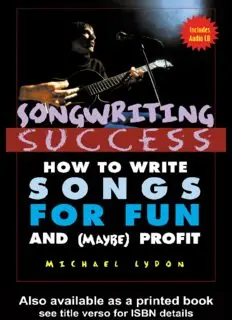
Songwriting Success: How to Write Songs for Fun and (Maybe) Profit PDF
Preview Songwriting Success: How to Write Songs for Fun and (Maybe) Profit
SONGWRITING SUCCESS HOW TO WRITE SONGS FOR FUN AND (MAYBE) PROFIT SONGWRITING SUCCESS HOW TO WRITE SONGS FOR FUN AND (MAYBE) PROFIT An introduction to the art and business of songwriting by one struggling singer- songwriter for the aid and comfort of other strugglers. MICHAEL LYDON Routledge New York • London 29 West 35th Street New York, NY 10001 http://www.routledge-ny.com/ Published in Great Britain by Routledge 11 New Fetter Lane London EC4P 4EE http://www.routledge.co.uk/ Copyright © 2004 Michael Lydon Routledge is an imprint of the Taylor &, Francis Group. Music examples by Steve Cohen Graphic examples by Michelle Drollette CD recorded at Batcave Studio, NYC. Engineer: Gary Dorfman CD edited and mastered at MacIntyre Music, NYC. Engineer: Reed Robins This edition published in the Taylor & Francis e-Library, 2005. “ To purchase your own copy of this or any of Taylor & Francis or Routledge’s collection of thousands of eBooks please go to http://www.ebookstore.tandf.co.uk/.” All rights reserved. No part of this book may be reprinted or reproduced or utilized in any form or by any electronic, mechanical, or other means, now known or hereafter invented, including photocopying and recording, or in any information storage or retrieval system without permission in writing from the author. 10 9 8 7 6 5 4 3 2 1 Library of Congress Cataloging-in-Publication Data Lydon, Michael. Songwriting success: how to write songs for fun and (maybe) profit: an introduction to the art and business of songwriting by one struggling singer-songwriter for the aid and comfort of other strugglers/Michael Lydon. p. cm. ISBN 0-203-49634-5 Master e-book ISBN ISBN 0-203-60630-2 (Adobe e-reader Format) ISBN 0-415-96929-8 (pb: alk. paper) 1. Popular music—Writing and publishing. I. Title. MT67.L93 2004 782.42′13—dc22 2003026492 for Ellen, my muse, my partner, my wife; and for Martha Sanders, Dave Lewis, Ed Fennell, Ron Wolfe, Zane Massey, Rudy Lawless, and Terry Newman, an inner few of the many guys and gals I’ve played with— thank you for your generous, soulful music. Contents Introduction ix A Note on the CD xi part I: The Art of Songwriting chapter 1: Deep Background 2 chapter 2: Reading Music 5 chapter 3: Chord Structures—Part I 10 chapter 4: Playing, Singing, and Performing 22 chapter 5: Lyrics—Part I 35 chapter 6: Song Forms 43 chapter 7: Melody 52 chapter 8: Rhythm 60 chapter 9: Style and Story 69 chapter10: Chord Structures—Part II 77 chapter 11: Lyrics—Part II 89 chapter 12: Refinements 100 part II: The Business of Songwriting chapter 13: Business Basics 106 chapter 14: Getting Heard 114 chapter 15: Song Contracts 124 chapter 16: Staying in Business 142 Appendix 145 Song Index 153 General Index 158 Introduction So you want to write songs? Join the club! The Lord must have told the Adam and Eve of songwriters, “Be fruitful and multiply.” So many of us minstrels are wandering the earth these days trying to be heard that I’d like to tell a few thousand of you, “Give me a break; quit and become accountants.” Fat chance! Joking aside, songwriters face constant competition. In every city and town, down the block in every neighborhood, other guys and gals are writing songs, and many of those guys and gals are good, really good. So, even if you are good, you may never win fame and fortune. For years your masterpieces may be heard by a circle little wider than your family and friends, earning only a fickle trickle that keeps you in guitar strings and groceries. While a few lucky bums, who are no damn better than you, are racking in the big bucks, Grammies, and covers by superstars! Maddening! I’ll try my best to steer you toward the big bucks, Grammies, and superstar covers, but since songwriting is a tough business, I also caution you: Don’t let making money be your only goal. If you do, you’ll most likely burn out from frustration. Don’t give up, but let this first lesson sink in: enjoy your work for the pleasure it gives you—that may be the only reward you’re gonna get. Writing songs, fortunately, delivers rich rewards. For creative challenges, lifelong learning, and just plain fun, nothing beats writing, singing, and playing your own songs. Looking back at my own thirty-year career, I remember the birthdays of new songs as golden moments in my life. These were days when I walked about on a little pink cloud, a new melody playing about my ears, my mind happily darting this way and that for the perfect rhyme, the perfect finishing phrase. I’ve had low moments too, of course, but living through them has given me three cornerstones: 1. Love of Craft—Enjoy songwriting; strive to improve your skills; respect songwriting’s traditions as you innovate. 2. Love of Self—Believe in your songwriting; write songs to tell the truth about feelings and ideas that matter to you. 3. Love of Other People—Use songwriting to share your joys and sorrows with other human beings. Ground your work on these cornerstones, and you will continue to write songs and to enjoy writing songs, no matter how well or badly you do in the marketplace. Actually, the best marketing tip of all is to make craft, self-expression, and reaching other people your deepest goals. Songs that become hits and then long-lived standards are, without exception, well-crafted songs that express true feelings and touch many hearts.
